If you’re expanding internationally, one of the first decisions you’ll face is this: Should you use Shopify Markets or create separate stores for each region?
This choice impacts your team, your customer experience, and your bottom line — yet most explanations online are either oversimplified or unclear.
This guide gives you a direct comparison of both setups: how they handle pricing, SEO, localization, payments, and operations — and when it actually makes sense to choose one over the other.
Before we get into the details, here are 5 things you’ll walk away knowing:
- Shopify Markets is simpler to manage but comes with limits around variants, apps, content control, and multi-currency payouts.
- Multiple stores give you full control over every region — but require more time, cost, and technical coordination.
- Currency conversion fees add up fast. At scale, avoiding them might save you more than running a second store costs.
- There’s no one-size-fits-all answer. Your team structure, catalog complexity, and legal setup will heavily influence the right choice.
- You can use both at the same time. Many brands run Shopify Markets for smaller regions and separate stores for major ones like the EU or Japan.
Bonus: Explore the difference between Shopify Markets and Expansion Stores!
Let’s start by making sure we’re clear on what Shopify Markets actually is — and what it can (and can’t) do.
Understanding Shopify Markets
Before you can compare Shopify Markets with managing multiple stores, you need to understand exactly what Shopify Markets offers — and what it doesn’t.
Many merchants jump into international selling with assumptions about what this feature does, only to run into limitations they didn’t expect. Let’s get clear on the capabilities, the setup process, and where the trade-offs lie.
What is Shopify Markets?
Shopify Markets is a built-in feature that lets you manage international selling from a single Shopify store. Instead of creating separate stores for different countries, you can define “markets” inside your existing store — each with its own settings for currency, language, pricing, and availability.
Here’s what that means in practice:
- A customer in France sees your site in French, with Euro pricing and European shipping options.
- A visitor from Canada sees the same store in English or French, with Canadian Dollars and local tax rules.
- You manage everything from one Shopify admin, without logging in and out of different store dashboards.
This centralized approach simplifies global selling — especially if you’re starting to expand and don’t have regional teams or dedicated infrastructure in place.
Core Features of Shopify Markets
Here’s a closer look at what Shopify Markets lets you do, and how it works behind the scenes.
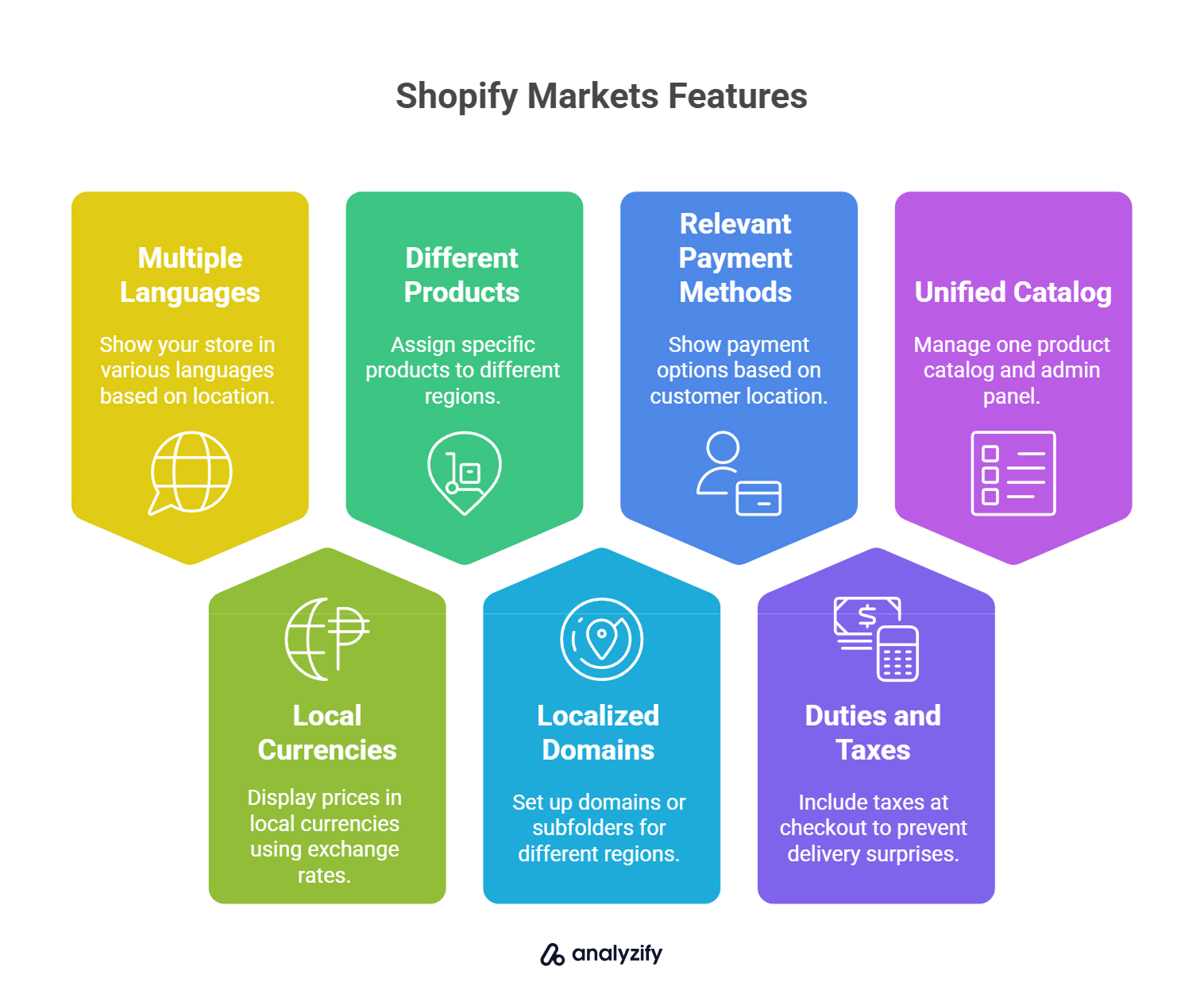
1. Localized Domains and URLs
You can assign specific domains, subdomains, or subfolders to different markets. For example:
- yourstore.com/fr for France
- yourstore.de for Germany
- uk.yourstore.com for the UK
Shopify automatically handles the technical parts — such as setting the correct hreflang tags — so search engines know which version of your site to show in each region.
2. Custom Product Availability
Markets allows you to control which products appear in each region. This is helpful if:
- Certain items can’t be shipped internationally
- Some collections are region-specific
- You want to limit what’s visible to certain markets
Note: You can hide entire products per market, but you can’t hide individual variants (like sizes or colors) without workarounds.
3. Language Settings
You can add multiple languages to your store and assign them to specific markets. Shopify Markets supports language switching based on the visitor’s browser or location — and you can manage translations using:
- Shopify’s free Translate & Adapt app
- Manual translation
- Third-party tools like Weglot or Langify
By default, Shopify did not automatically change a store’s language based on the visitor’s location.
However, with the introduction of the Language redirection feature on January 15, 2024, you can now enable automatic redirection based on the visitor’s browser language. To activate this feature, follow these steps:
Activate Automatic Redirection
- Log in to your Shopify admin panel.
- Go to Settings > Markets.
- Click on Preferences.
- In the Automatic redirection section, activate Country/region redirection.
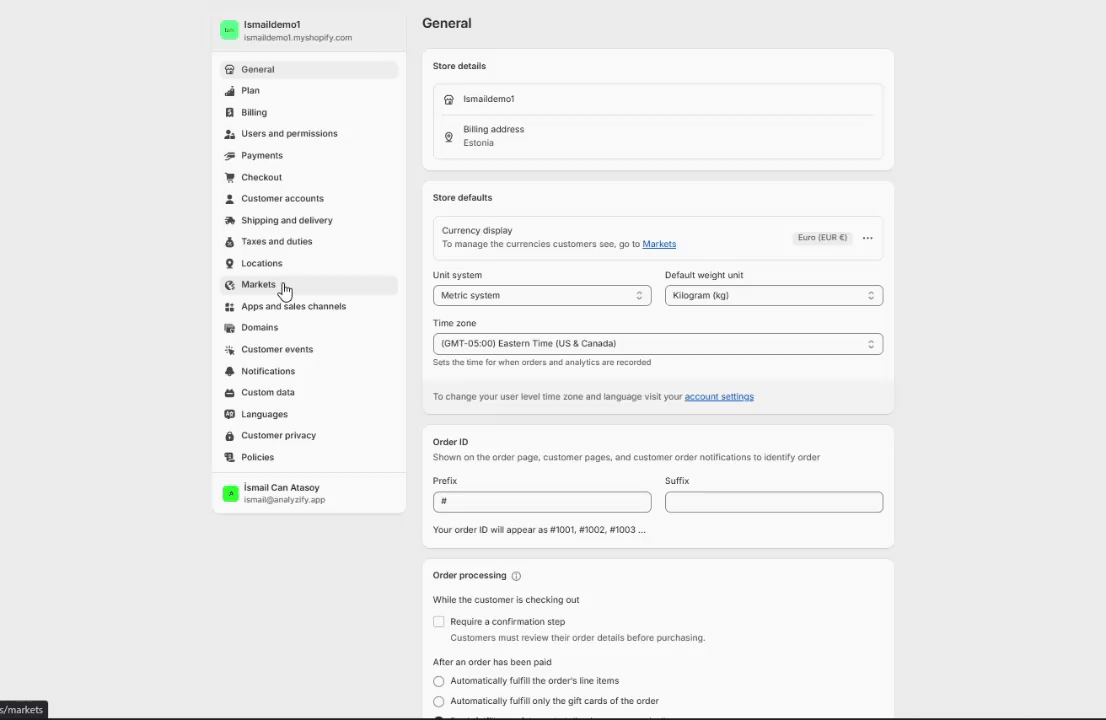
After activating country/region redirection, region-specific content is automatically displayed to customers in your online store.
You can also let customers manually switch between countries and languages by enabling selectors on your online store. If your theme doesn’t have a built-in country or language selector, you can add them using a third-party app from the Shopify App Store.
Note: Automatic redirection is based on the customer’s IP address, directing them to the appropriate regional store without the need for a pop-up.
For example, if your primary domain is shop.com for the U.S., and you’ve set up a Canadian market at shop.com/en-ca, customers from Canada will be automatically redirected to the /en-ca subfolder.
4. Currency and Pricing Control
Shopify Markets supports two ways of pricing:
- Automatic currency conversion based on real-time exchange rates
- Manual fixed pricing per market, so you can adjust for local pricing strategies
However, all payments are still settled in your store’s default currency unless you’re on Shopify Plus and using expansion stores. This is an important limitation for some businesses.
5. Duties and Tax Calculation
Shopify Markets allows you to show import duties and local taxes at checkout, helping customers avoid unexpected fees at delivery. This transparency improves trust and often leads to higher conversion rates.
You can enable this feature in two ways:
Built-in Shopify functionality: From your Shopify admin, go to Settings > Taxes and Duties and enable duty and import tax calculation. Shopify will automatically calculate the correct amounts at checkout for supported countries.
Third-party apps: If your setup doesn’t qualify for Shopify’s built-in tool, apps like Zonos or Gloabl-e can handle duties and tax estimates during checkout.
But keep in mind—if you don’t activate this feature or use a third-party service like Zonos or Global-e, your customers might still have to pay duties upon delivery, depending on local tax rules.
Note: Shopify charges a 0.5% transaction fee on orders where duties and taxes are collected at checkout (as of February 2025). This applies even if you’re not using Shopify Payments.
6. Local Payment Methods
Shopify automatically shows popular local payment options for each market — as long as you’re using Shopify Payments. For example:
- iDEAL in the Netherlands
- Klarna in Germany
- Bancontact in Belgium
But if Shopify Payments isn’t available in your region, you’ll need workarounds — and some multi-currency features won’t be accessible.
7. Unified Admin, Centralized Management
Everything is managed through a single Shopify admin panel. You don’t need to duplicate products or log into separate stores. That’s a major operational benefit if:
- You have a small team
- You want to expand quickly
- You prefer to streamline your workflows
Bonus: Explore Choosing Between Shopify and Shopify Plus!
Implementation Process: What It Takes to Set Up
Getting started with Shopify Markets doesn’t require a developer or a complex setup. You can enable it directly from your Shopify admin.
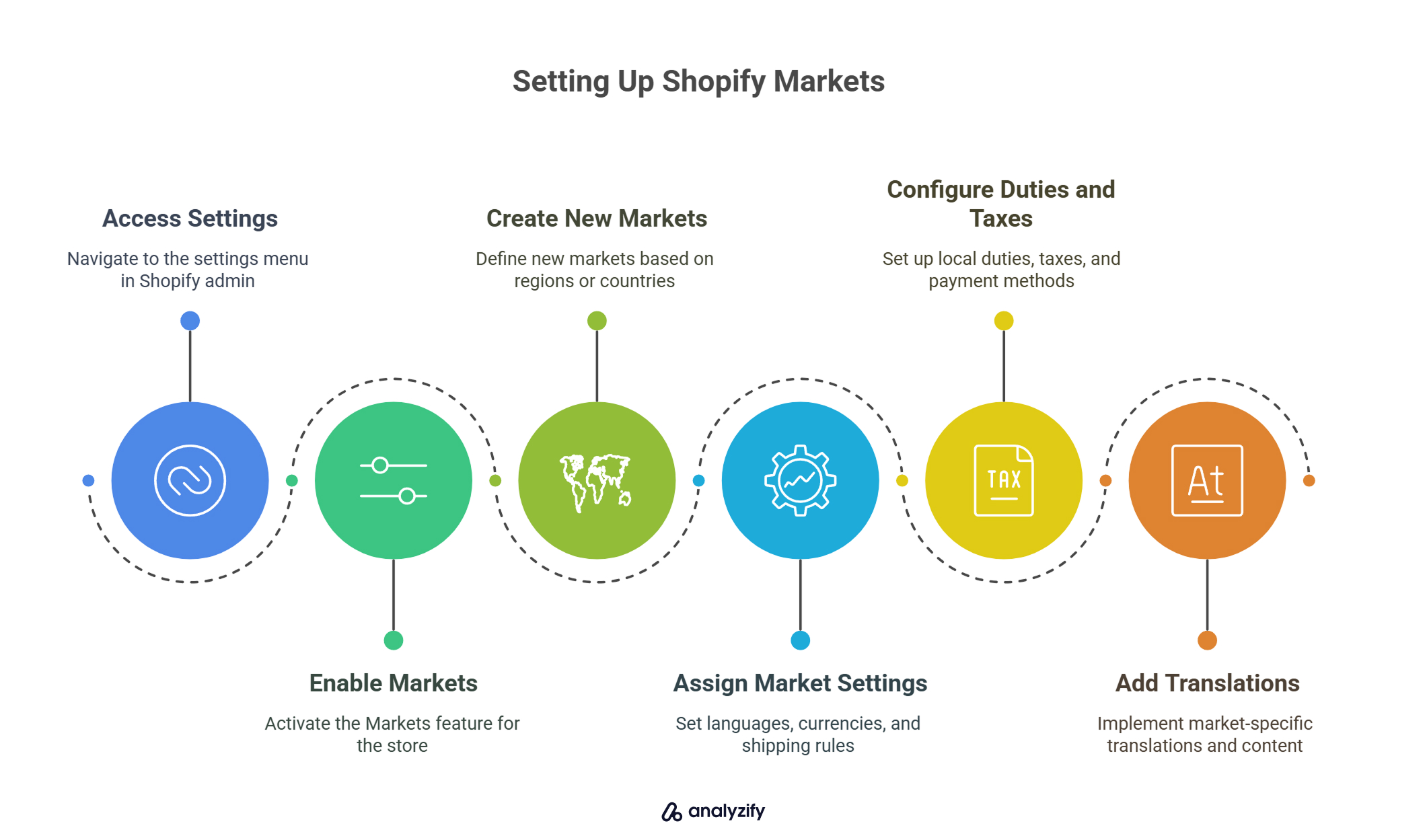
Here’s what the process looks like:
1) Go to Settings > Markets and enable Markets for your store.
2) Create new markets based on countries or regions (e.g., Europe, Asia, US).
3) Assign settings for each market:
- Languages
- Currencies
- Products available
- Shipping rules
- Domains or subfolders
4) Configure duties, taxes, and local payment methods.
5) Add translations and market-specific content where needed.
Shopify handles the SEO configuration and redirection logic for you. In most cases, the technical lift is minimal — but the strategic decisions you make during setup (what to show, how to price, how to localize) are what really determine your success.
Bonus: Discover “ Top Shopify Alternatives: Compare Pricing & Features”
When Shopify Markets Makes Sense
Shopify Markets works well if:
- You want to expand internationally without managing multiple stores
- Your branding and content are mostly consistent across regions
- You’re okay with some limitations around variants, translation, and customization
- You’re fine with receiving payments in one currency, and the conversion fees (1.5–2%) don’t heavily impact your margins
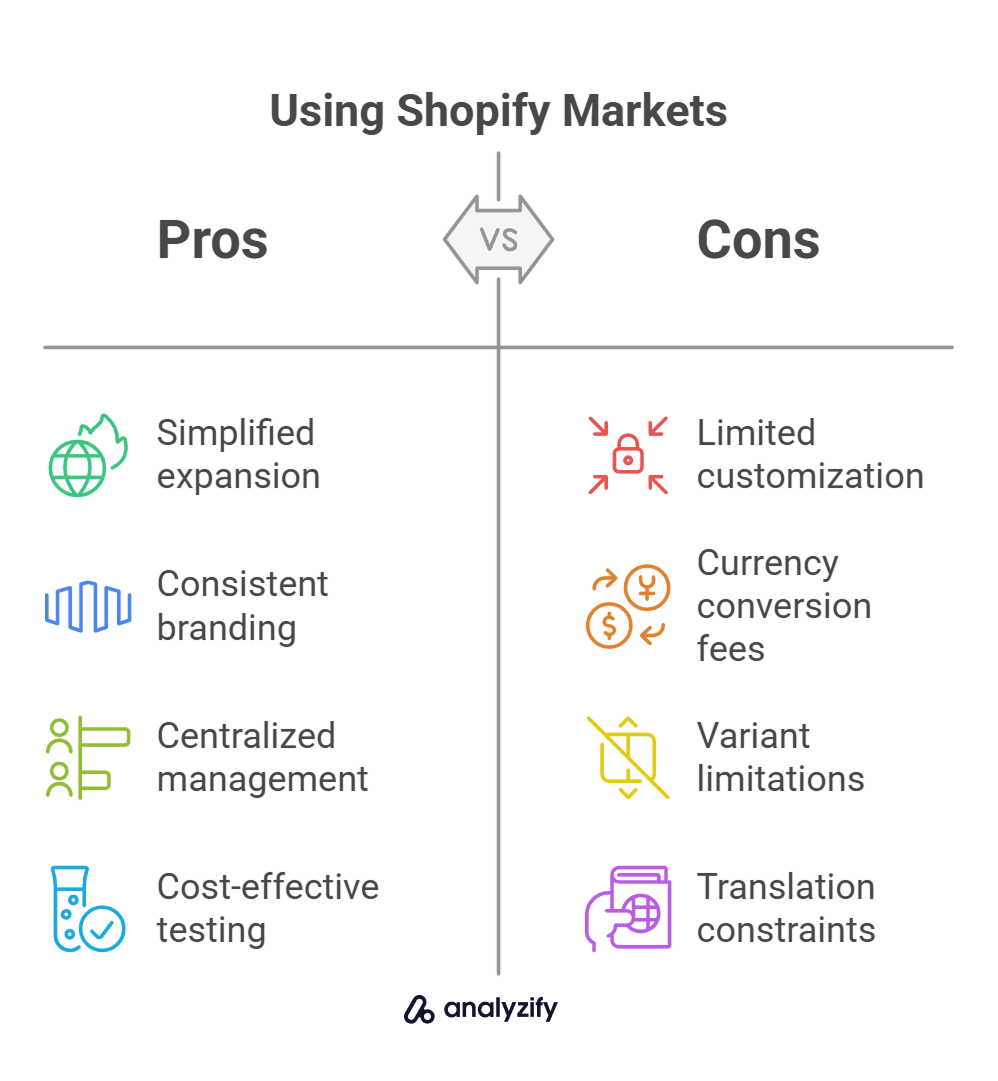
If you’re early in your international journey, have a centralized team, or want to test global markets before investing in multiple storefronts — this is likely the place to start.
Next, let’s look at how managing multiple independent Shopify stores compares — and why some merchants choose that path instead.
Understanding Multiple Shopify Stores
Now that you have a clear understanding of what Shopify Markets offers, let’s look at the alternative: running multiple Shopify stores.
This setup is often referred to as “multi-store” or “separate stores,” and it’s common among merchants with diverse product catalogs, regional teams, or legal obligations that require distinct setups per market.
But unlike Shopify Markets, this approach comes with higher costs and more complexity. So why do some merchants still choose it?
Let’s break it down.
What Are Multiple Shopify Stores?
A multi-store setup means you create entirely separate Shopify stores for different countries, languages, or customer groups.
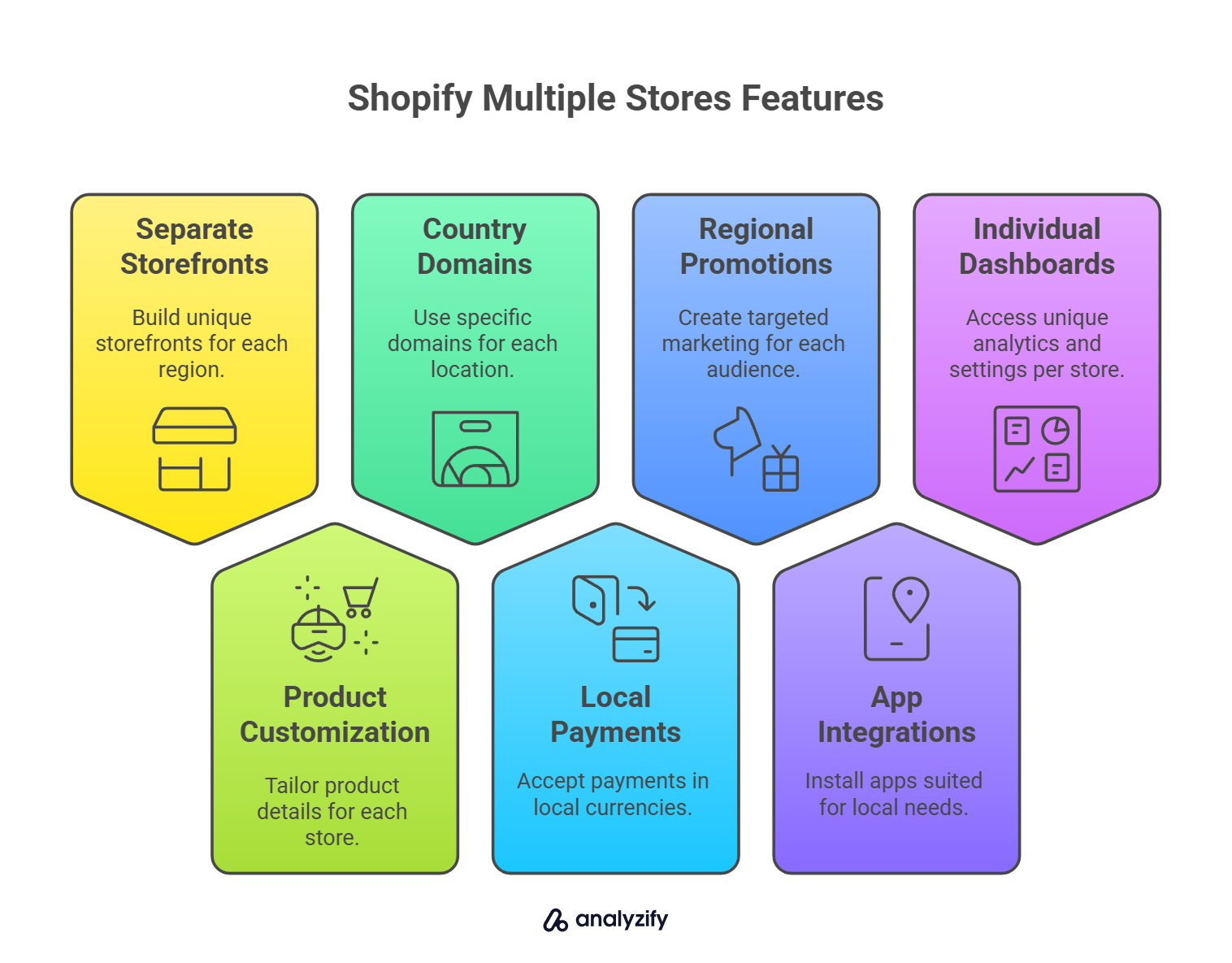
Each store is its own account with:
- Its own admin dashboard
- Its own Shopify subscription (e.g., $39/month or higher per store)
- Independent products, themes, apps, and settings
This gives you full control over every element of the store experience in each region — but it also means more work.
You can have multiple Shopify stores on any plan, including Basic and Advanced, but they’re completely disconnected unless you integrate them manually or use third-party tools.
There’s no automatic link between stores — you manage each one separately.
Bonus: Here our hand-picked list of Top 10 Shopify Plus Agencies for Ecommerce!
Core Benefits of Using Multiple Stores
This approach gives you far more freedom and independence per market. You’re not limited to shared themes or centralized product catalogs. Instead, each store can operate like its own localized business — from checkout to design.
Here’s what that looks like in practice:
1. Complete Design Freedom
You can create an entirely different design for each regional store.
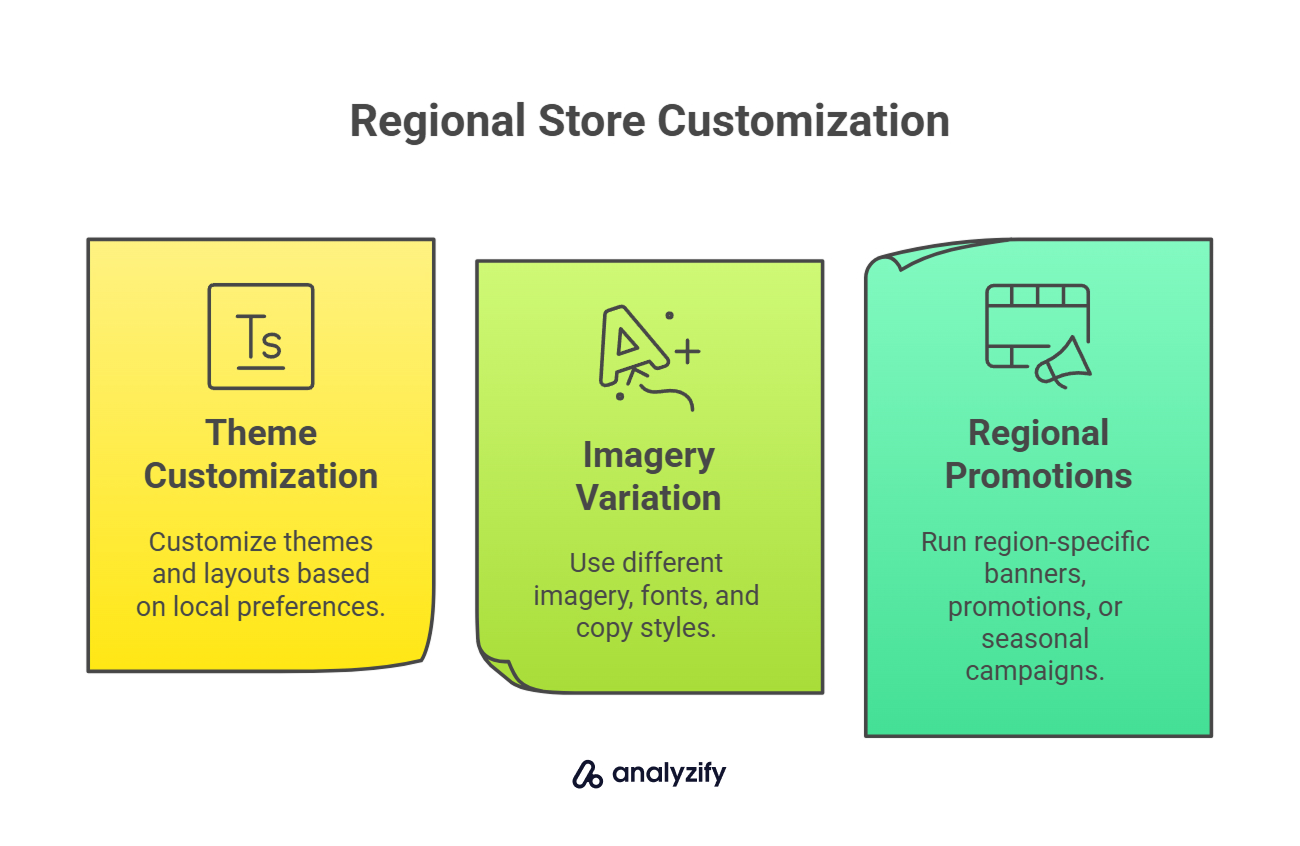
This allows you to:
- Customize themes and layouts based on local preferences
- Use different imagery, fonts, and copy styles
- Run region-specific banners, promotions, or seasonal campaigns
You’re not forced to keep visual consistency across countries if that’s not what works for your audience.
2. Custom Product and Variant Control
Unlike Shopify Markets, which lets you hide entire products per region but not variants, multiple stores let you:
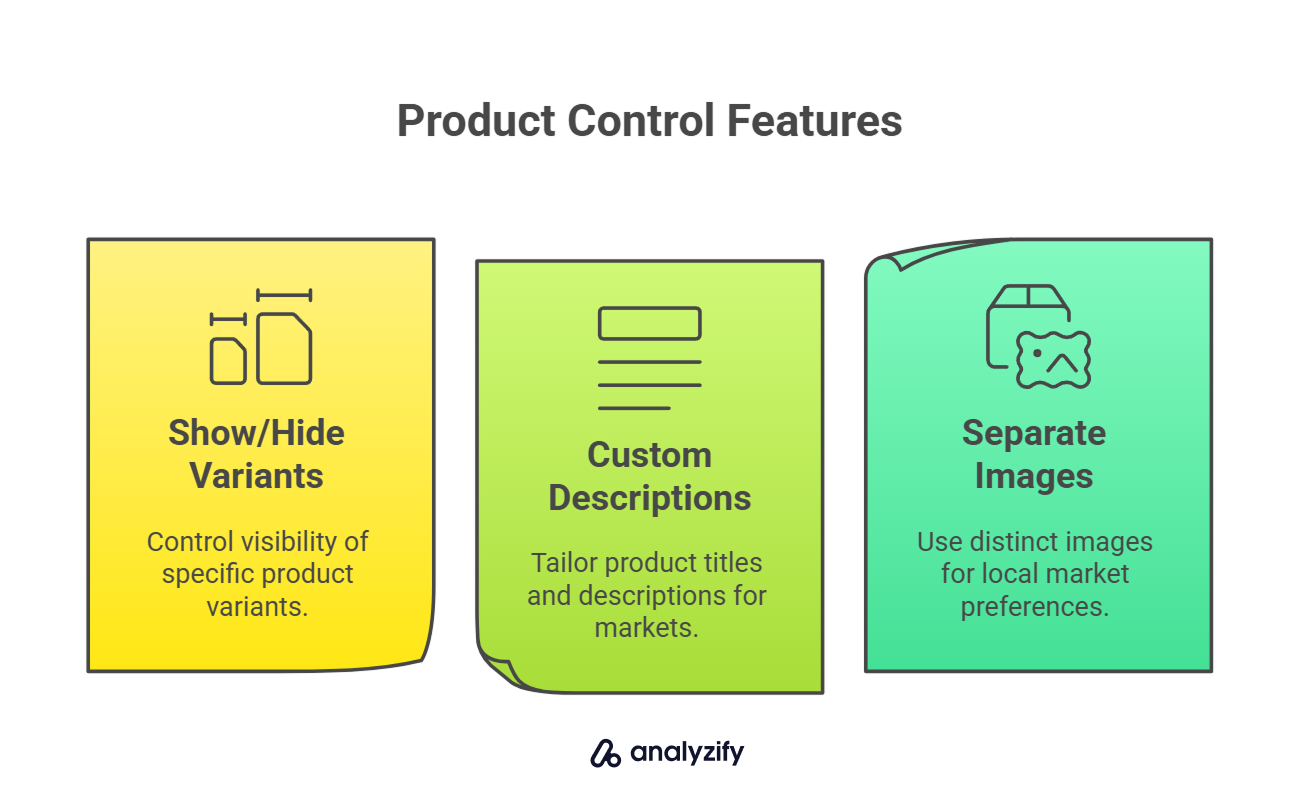
- Show or hide specific variants like sizes, colors, or materials
- Create different product descriptions or titles for the same item
- Use separate images or product bundles tailored to local demand
This is particularly useful if sizing conventions, regulations, or product preferences vary significantly across markets.
3. Localized Checkout and Payment Flexibility
Each store can be configured independently to:
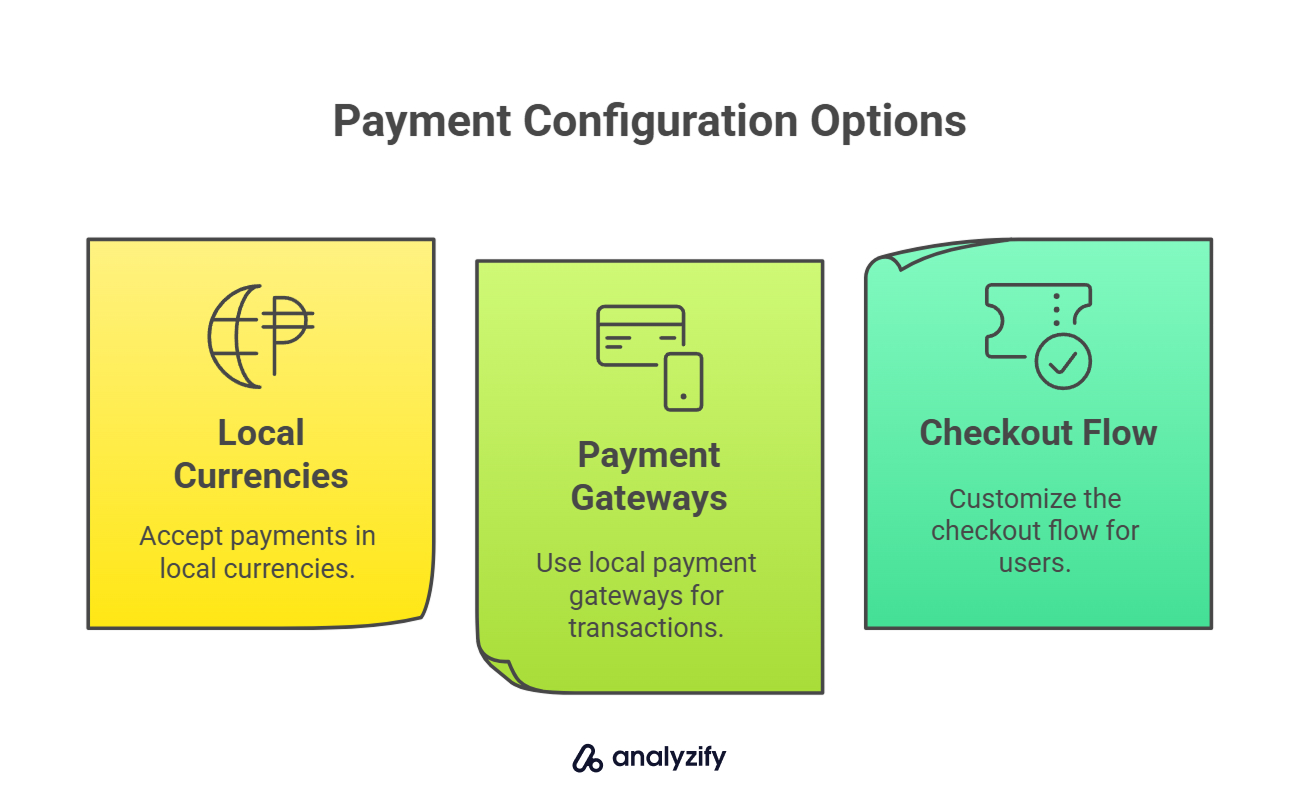
- Accept payments in local currencies
- Use local payment gateways — even if Shopify Payments isn’t supported
- Customize the checkout flow based on legal or user experience requirements
There’s no need to rely on Shopify’s default currency or workaround limits on payment processors.
4. Independent App Stacks and Integrations
App compatibility is often a deal-breaker for merchants using Shopify Markets. With multiple stores, that issue disappears.
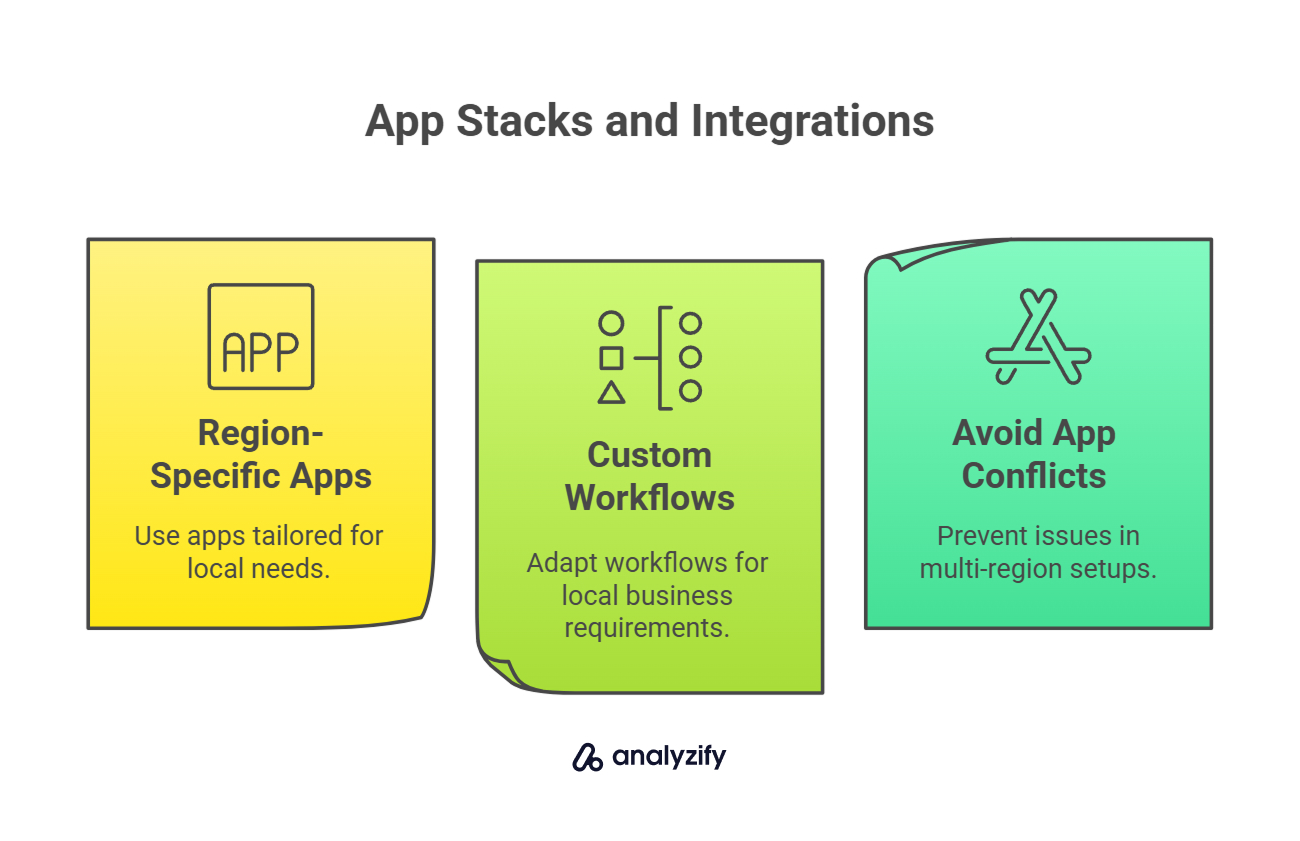
You can:
- Use region-specific apps for fulfillment, reviews, loyalty programs, and more
- Customize workflows to suit local business needs
- Avoid app conflicts that arise in multi-region setups on a single store
You’re free to build the tech stack each store actually needs — not just what works globally.
5. Separate Domains and SEO Strategy
Each store can have its own primary domain (like yourbrand.ca or yourbrand.de), which enables:
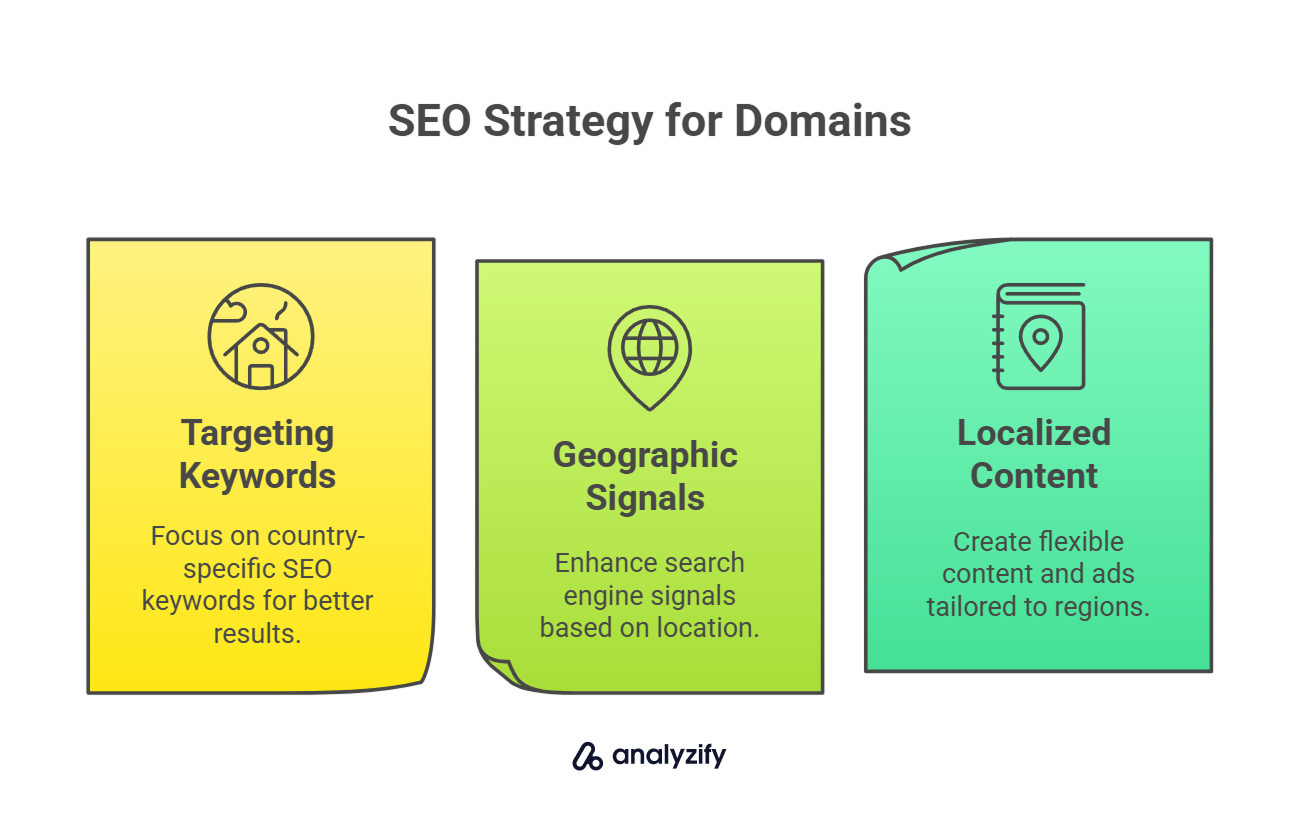
- Better targeting with country-specific SEO keywords
- Stronger geographic signals to search engines
- More flexibility for localized content and ad campaigns
This strategy works well if organic search is a key channel for your business and you want maximum control over each region’s search visibility.
Cost and Operational Considerations
The benefits of multiple stores come at a cost — both financially and operationally. If you’re considering this route, it’s important to understand the additional resources required.
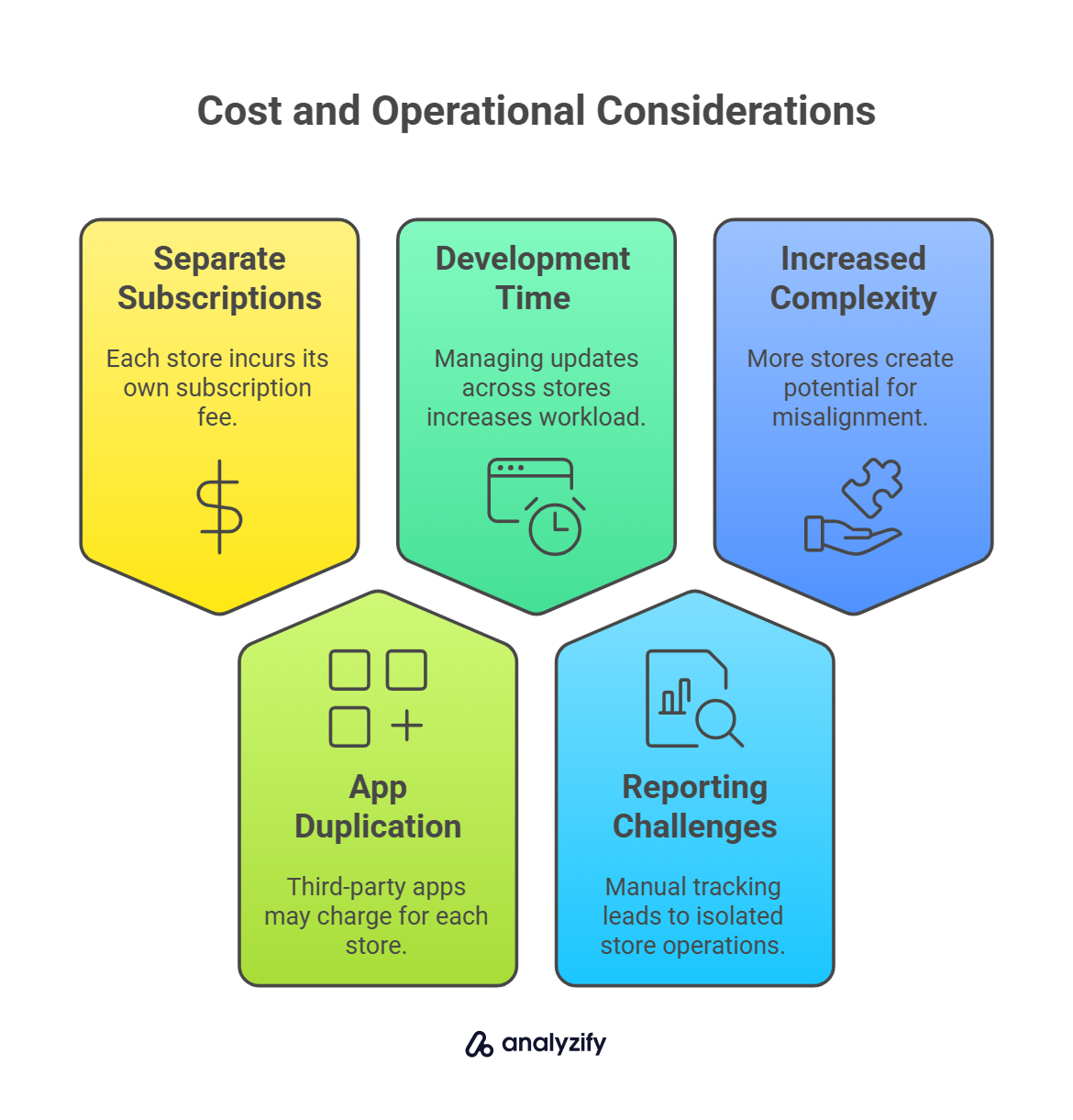 Here’s what to account for:
Here’s what to account for:
- Separate Shopify subscriptions: Each store is billed independently (starting at $39/month).
- App duplication: Most third-party apps charge per store, which can multiply quickly.
- Increased development time: New themes, content, or updates must be managed across multiple storefronts.
- Manual reporting and inventory tracking: Unless you integrate reporting or PIM systems, each store functions in isolation.
- Higher complexity: More stores mean more moving parts, which can lead to misalignment without clear processes.
In short, you’re trading simplicity for flexibility. For many businesses, that trade-off is worth it — but it should be intentional.
Bonus: Learn more about Shopify Fulfillment Network: Costs, Features, and Alternatives!
When Multiple Stores Make Sense
Managing multiple Shopify stores makes sense if:
- You need full customization per market, including layout, checkout, or content
- You want to avoid conversion fees by accepting payouts in local currencies
- You have separate legal entities in different countries
- You’re selling exclusive products or variant sets by region
- You work with regional teams who need independent access and control
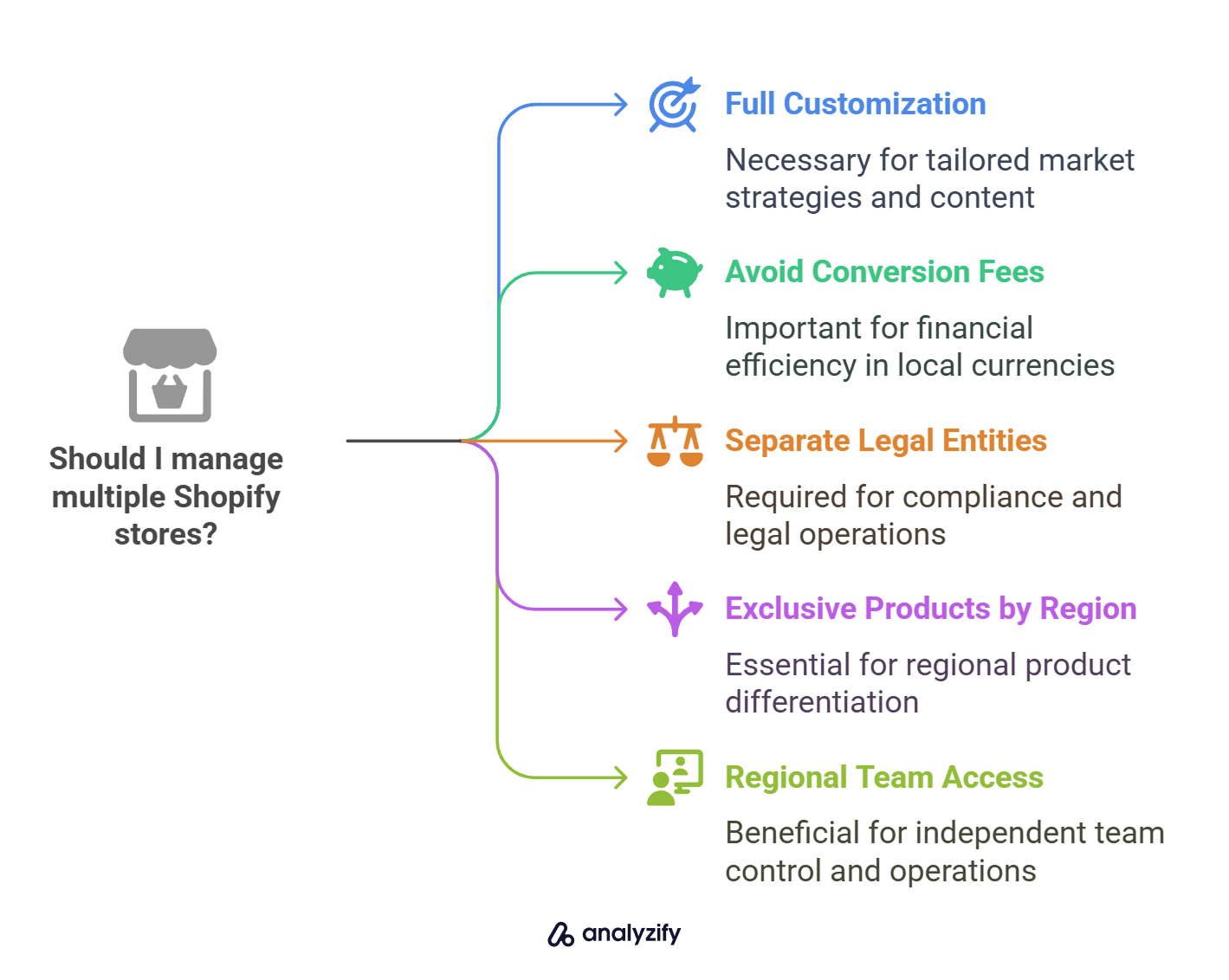
If you have the team, budget, and need for total localization — this setup gives you maximum flexibility. But if you’re early in your expansion journey, or working with limited resources, it may be more than you need right now.
Shopify Markets or Multiple Stores: 7 Critical Decision Factors
Now that you’ve seen what Shopify Markets and multiple stores can offer, let’s compare them based on the factors that actually matter when expanding internationally. These are the areas where differences show up clearly in day-to-day operations — from payment handling to app compatibility.
To make this concrete, we’ll use a consistent example: You run a U.S.-based footwear brand that’s starting to sell in the UK, EU, and Asia.
You’re growing steadily and want to localize the customer experience without creating unnecessary work or cost. Let’s walk through the decision points that should guide your setup.
1. Cost and Fees
Start with the financial side: what’s the real cost of each setup?
Shopify Markets charges no base fee — you pay for one Shopify plan — but there’s a currency conversion fee on international orders (1.5% in the U.S., 2% elsewhere). These fees apply any time a customer checks out in a different currency than your payout account.
Multiple Stores avoid conversion fees entirely if each store accepts payments in its local currency. But you’ll pay for each Shopify plan separately, along with duplicated apps and integrations.
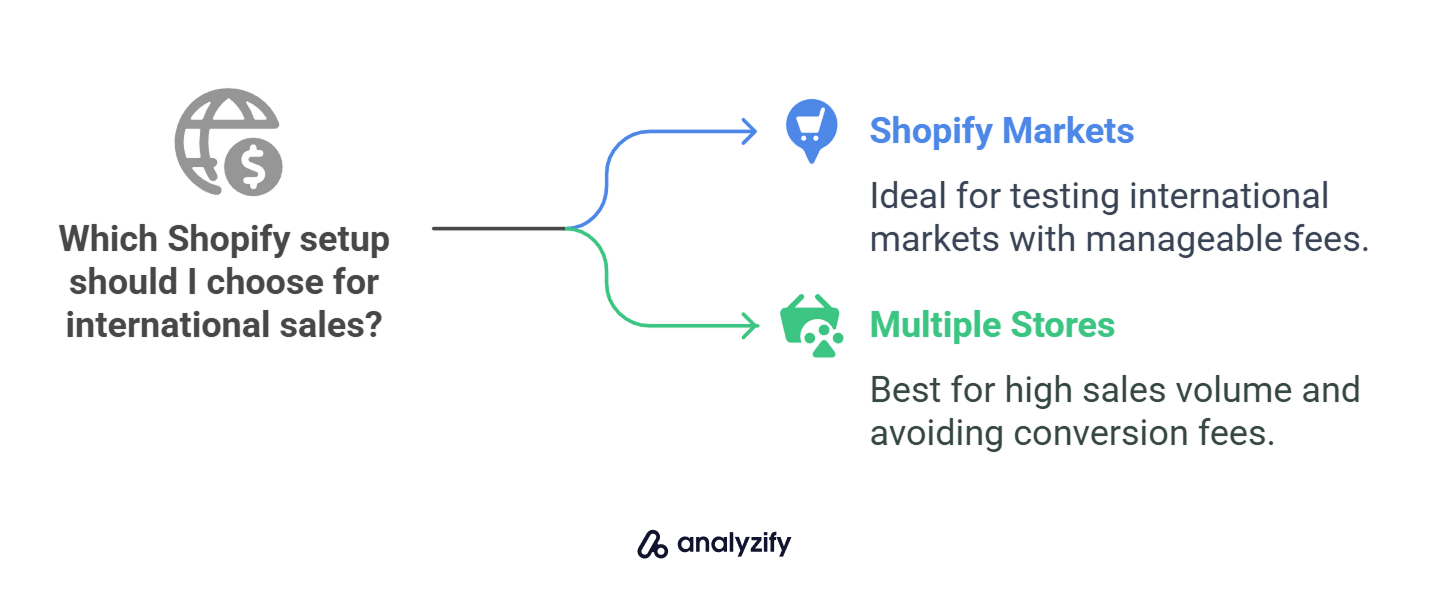
Choose Shopify Markets if:
- You’re still testing international markets
- Your sales abroad don’t justify extra subscriptions
- A 2% fee is acceptable for convenience and simplicity
Choose Multiple Stores if:
- You expect high sales volume in specific countries
- You want to avoid conversion fees entirely
- You already manage complex setups and can afford the added cost
👉 Example: If your UK store generates $500,000/year, Shopify Markets would cost you about $10,000 in conversion fees. Running a second store at $39/month might be a more affordable long-term solution — especially if you’re also paying for apps per store.
2. Team Structure
The way your team works will shape how smoothly each setup runs.
With Shopify Markets, all regions share a single admin. This works best when one centralized team manages product updates, campaigns, and support. But only one person can edit the theme at a time, which may cause delays if your team grows.
Multiple stores give each region its own space. Teams can update products, run promotions, and localize content without interfering with other markets.
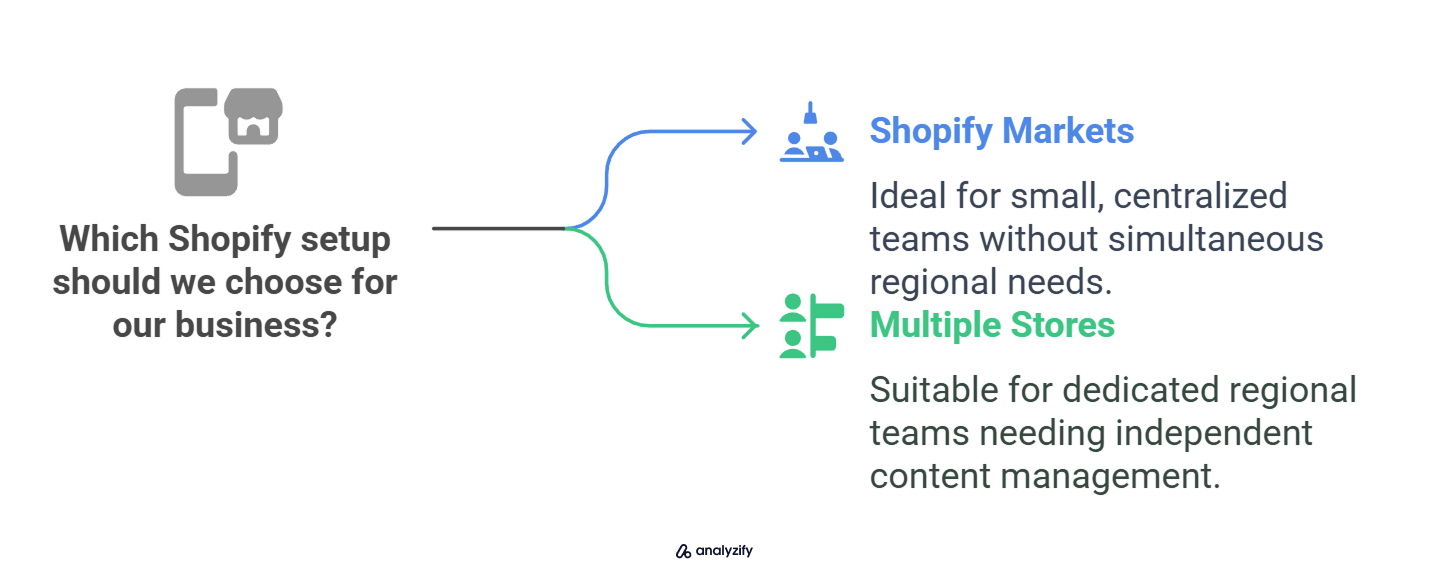
Choose Shopify Markets if:
- You have a small, centralized team
- Your regions don’t need to work on the site at the same time
Choose Multiple Stores if:
- You’re building dedicated teams in each region
- Team members need to manage content or campaigns independently
👉 Example: As your footwear brand expands, you hire a marketing lead in London. They need to launch UK-specific promotions and update seasonal campaigns — without waiting for the U.S. team to log off. In this case, separate stores keep things moving.
3. Localization and Language Control
Delivering a fully localized experience goes beyond just translation.
Shopify Markets supports multiple languages and currencies, but some elements — like popups, navigation menus, and footers — are hard to localize per market. Marketing emails are also tricky unless you use external tools like Klaviyo.
With multiple stores, you can localize every part of the site — layout, messaging, imagery, email flows — without compromises.
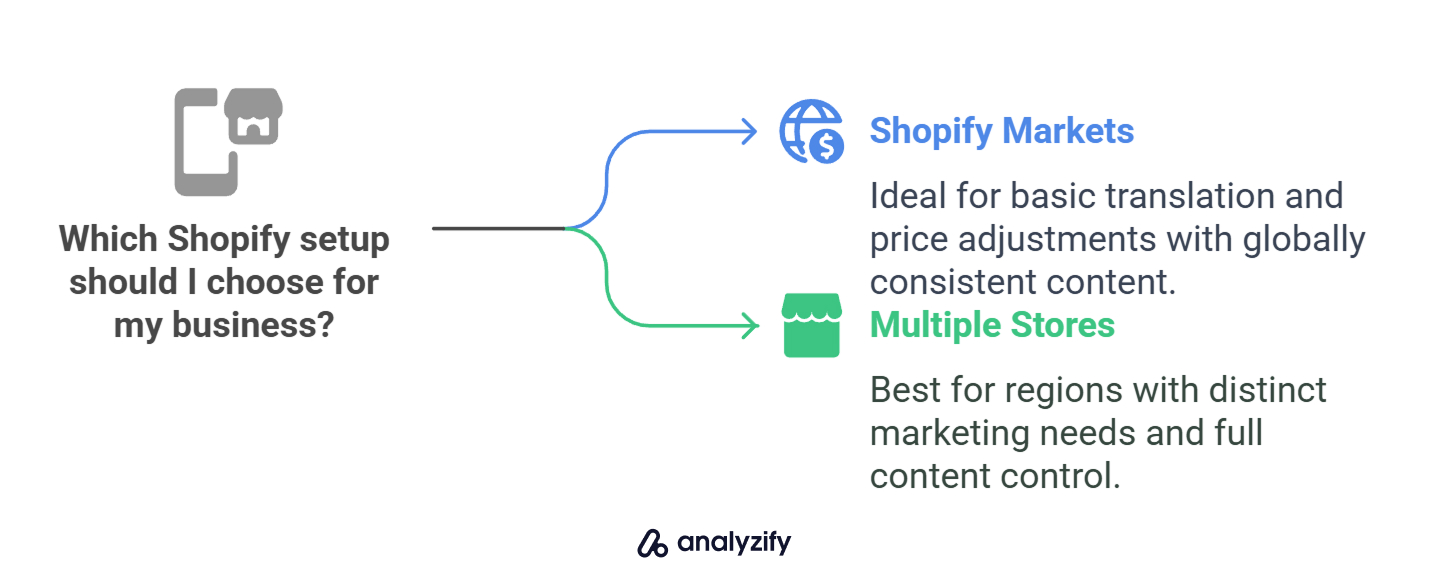
Choose Shopify Markets if:
- You only need basic translation and price adjustments
- Most of your content works globally with small tweaks
Choose Multiple Stores if:
- Your marketing and brand tone differ by region
- You need to fully control content, images, and UX per store
👉 Example: Your U.S. product pages feature outdoor lifestyle imagery, while in Japan, you want clean studio shots with sizing and fit notes. Shopify Markets can’t serve different media or layouts per region, but multiple stores can.
4. Product and Variant Control
Product availability can get complicated fast — especially with sizing and regulations.
Shopify Markets lets you hide or show entire products per market, but you can’t control visibility at the variant level (e.g., individual sizes or colors). That’s a major limitation for footwear.
With multiple stores, you can display only the sizes, materials, or collections that apply in a given region. You can also change descriptions, pricing, and imagery per variant.
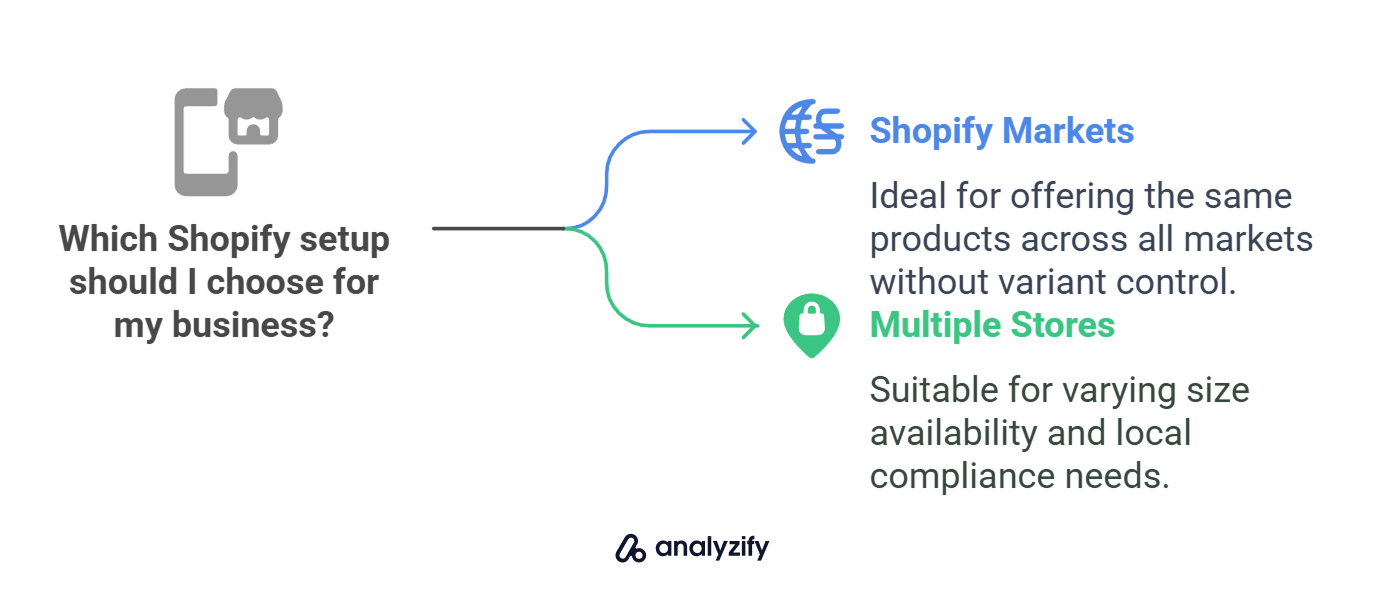
Choose Shopify Markets if:
- You’re offering the same products in every market
- You don’t need to control which variants appear per region
Choose Multiple Stores if:
- Size availability differs across regions
- You need to follow local labeling or product compliance rules
👉 Example: You sell women’s sneakers in the U.S. up to size 12, but in the EU, your factory only produces up to size 10. With Markets, you’d have to hide the entire product. With multiple stores, you can simply hide the size 11 and 12 variants in the EU store.
5. SEO and Domain Strategy
Your domain structure directly affects how search engines understand and rank your site in different countries.
Shopify Markets uses a single domain with subfolders for each market (e.g., yourstore.com/uk, yourstore.com/de). Shopify automatically handles SEO best practices like hreflang tags and redirections, which is helpful if you want to consolidate your SEO authority under one domain.
Multiple stores, on the other hand, allow each region to have its own separate domain — like yourstore.co.uk or yourstore.jp. This gives you more control over regional SEO strategies, keyword targeting, and country-specific content.
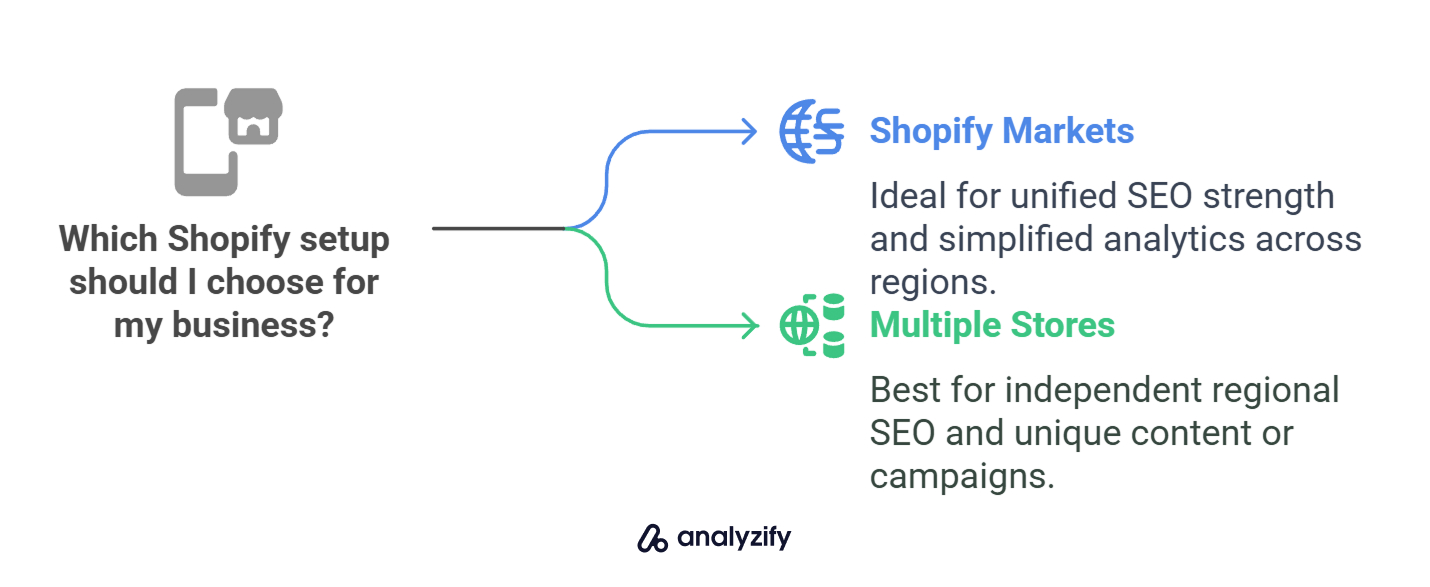
Choose Shopify Markets if:
- You want to build SEO strength under one domain
- Your content is similar across regions
- You prefer simplified analytics and SEO tracking
Choose Multiple Stores if:
- You want each region to rank independently with unique content
- Your SEO keywords vary significantly by language or country
- You run separate Google Shopping feeds or paid campaigns by region
👉 Example: Your U.S. site ranks for “women’s trail sneakers,” but in Germany, you want to focus on “leichte damen-sportschuhe.” With Shopify Markets, you’re tied to one SEO structure. With multiple stores, you can build a localized keyword and backlink profile for each region.
6. Legal Entity and Tax Structure
Legal requirements vary from country to country — especially when it comes to taxes, compliance, and invoicing.
Shopify Markets works best if your business operates as a single legal entity. You can collect VAT or GST where required, but all revenue flows into your main account. If you’re using Shopify Markets Pro, you also get automated import tax handling for certain countries.
With multiple stores, each one can operate under a different legal entity — making it easier to handle country-specific tax filing, accounting, or business registration.
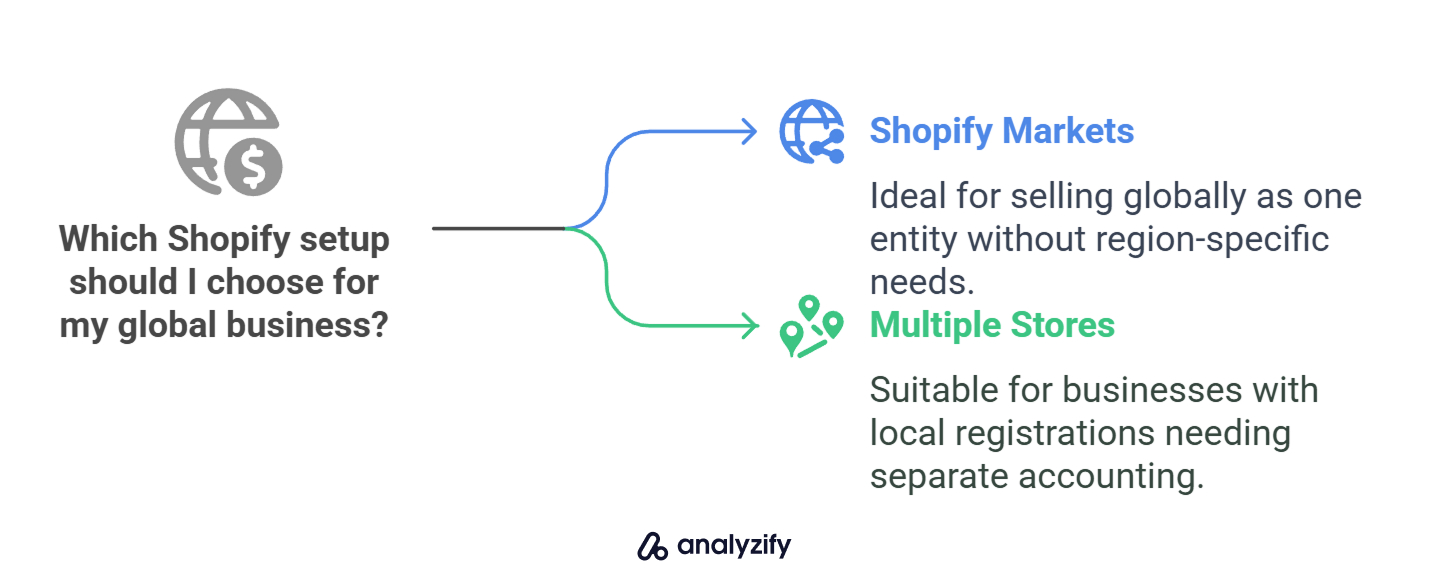
Choose Shopify Markets if:
- You’re selling globally as one legal entity
- You don’t need region-specific invoicing or financial separation
Choose Multiple Stores if:
- You have local business registrations in other countries
- You need to separate accounting, taxes, or compliance by market
👉 Example: You register a UK-based entity for your footwear brand to simplify VAT obligations. With Shopify Markets, you’d struggle to split the financials. With a dedicated UK store, you can track revenue, taxes, and compliance cleanly.
7. Shipping, Fulfillment, and Inventory Sync
Finally, your ability to manage orders, stock, and delivery timelines across regions can make or break your global setup.
Shopify Markets supports localized shipping rates and zones, but inventory is shared across markets unless you create location-based rules or use a third-party app. You can assign different fulfillment centers per region, but some scenarios require creative workarounds.
Multiple stores make inventory separation easy. Each store can have its own warehouse, carrier options, and shipping logic — all without overlaps.
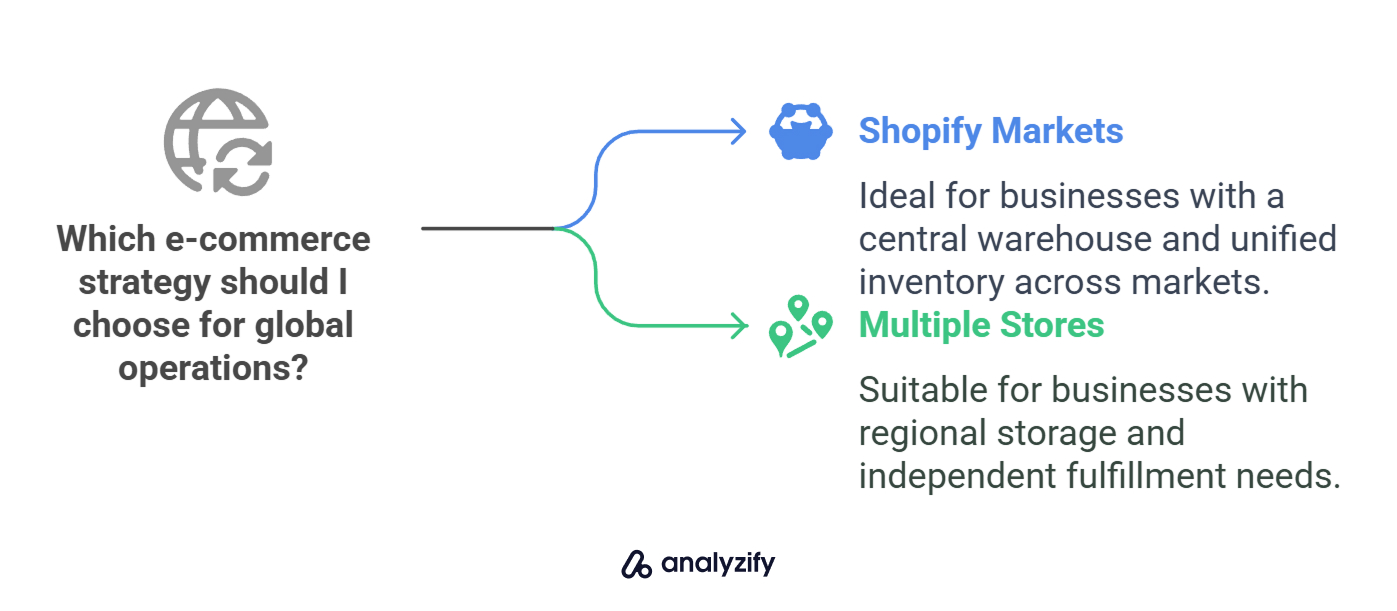
Choose Shopify Markets if:
- You have a central warehouse that ships globally
- You’re fine using the same inventory pool across all markets
Choose Multiple Stores if:
- You store products in different regions
- You want to manage fulfillment centers independently
- You need different shipping methods, timelines, or carriers by country
👉 Example: You warehouse your sneakers in both New Jersey and Rotterdam. With Shopify Markets, customers in Asia may accidentally order from the U.S. warehouse. With multiple stores, your EU and U.S. sites operate independently — no confusion, no surprise shipping fees.
Shopify Markets vs. Multiple Stores: FAQ
Here are the frequently asked questions about using Shopify Markets versus managing multiple Shopify stores.
What’s the difference between Shopify Markets and multiple stores?
Shopify Markets lets you sell internationally from one store by customizing pricing, language, currency, and product availability for each region. Multiple stores means creating separate Shopify accounts for different countries or customer groups, each with its own admin, settings, and tech stack.
Markets is easier to manage but has more limitations. Multiple stores offer full control, but they’re more expensive and complex to run.
Can I use Shopify Markets without Shopify Plus?
Yes. Shopify Markets is available on all Shopify plans, including Basic and Advanced. You don’t need Shopify Plus to use it.
However, if you want expansion stores (a special kind of multiple-store setup under one Plus account), you’ll need Shopify Plus.
Do I need a separate store for each country?
Not always. If your content, pricing, and logistics are mostly the same across regions, Shopify Markets is likely enough.
You may need separate stores if:
- You want local currency payouts
- You operate under different legal entities
- You need fully separate content, apps, or checkout flows
Can I have different product prices in each country with Shopify Markets?
Yes. Shopify Markets lets you set manual fixed prices for each market or use automatic currency conversion. You can adjust product pricing based on local market conditions, taxes, or shipping costs.
Can I hide products or variants in Shopify Markets?
You can hide entire products from specific markets, but you cannot hide individual variants (like specific sizes or colors). If you need that level of control, multiple stores are the better option.
Does Shopify Markets support different payment methods per region?
Yes, but only if you’re using Shopify Payments. The system will automatically show popular local payment options like iDEAL (Netherlands), Bancontact (Belgium), or Klarna (Germany), depending on the customer’s location.
If Shopify Payments isn’t available in your country, this feature may be limited.
Do I need to pay for each Shopify store separately if I use multiple stores?
Yes. Each Shopify store has its own subscription and billing. If you’re not on Shopify Plus, you’ll pay for each plan individually, starting at $39/month per store. App costs are also duplicated unless the app supports cross-store licensing.
Is Shopify Markets good for SEO?
Shopify Markets uses subfolders (like /uk, /de, etc.) and automatically sets up hreflang tags and redirects to help search engines show the correct version of your site. This works well for building authority under one domain.
However, if you want country-specific domains and unique SEO strategies per region, multiple stores offer more flexibility.
Can I use both Shopify Markets and multiple stores together?
Yes, many large brands do exactly that. You might use Shopify Markets to manage smaller regions from one store, and use separate stores for your biggest markets (like the U.S., EU, or Japan). This gives you a hybrid setup with a balance of control and simplicity.

































